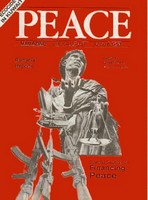Newsworthy
By Richard Sanders, Mac Scott | 1991-07-01 12:00:00
Red Hot Canadian Machine Guns Now On Sale!
By Macdonald Scott
On the subject of arms control, the Government has solved a major problem. By tabling new legislation, they have wiped aside an inadvertent barrier to automatic weapons exports in the criminal code. Weapons manufacturers had long protested this block to their overseas sales, said one executive: "Canadian Companies can legally sell bombs, missiles, chemicals and all other kinds of mayhem, but you can't sell an automatic weapon." It seems this was a major catastrophe. Canadian gun manufacturers, among the "best" in the world, were unable to export their product. But not anymore. With new legislation proposed by Joe Clark, they can now export as many guns as they like.
Clearly the Gulf war showed just how important it is that Canadian arms manufacturers be able to enter the booming market of weapons sales as easily as possible, despite rhetoric about the "importance of arms control" delivered by Joe Clark and Mulroney after the war. Thank goodness that this little problem has been cleared up.
Meanwhile the U.S. just announced new arms sales to the Middle East.
Flaws, Gaps and Loopholes
By Richard Sanders
OTTAWA-Canada's new reporting system on the export of military goods does little to control our export of military equipment. Introduced to Parliament with great fanfare on March 6 by Joe Clark, the new reporting system has more to do with fending off rising public opposition. The Annual Report follows up on a commitment made by Clark in his address to the UN General Assembly on September 26, 1990.
A critical examination of the reporting system reveals several flaws, gaps and loopholes.
- 1. Perhaps the biggest problem with the Annual Report is that although the United States is by far the largest importer of Canadian military technology, the report does not include any of these sales. Most of the military technology which Canada exports to the United States is in the form of component parts. The United States assembles these Canadian components into weapons and their delivery systems and then exports about 20% of them. About half of these U.S. exports end up in the Third World. No permits from External Affairs are required for Canadian arms producers to export their military equipment to the United States. As a result, Canada has no say over where that Canadian equipment is re-exported.
- Canada is in fact the largest supplier of military parts to the United States. As such, Canadian components have always played an essential role in the military exploits of our "Big Brother" to the south. During the Vietnam war, for instance, the Canadian military industry received its most lucrative boost to date.
- 2. The other major loophole is that the Annual Report lists only those forms of technology which are defined in Group 2 (Munitions) of Canada's Export Control List. That means that only technology "specifically designed or adapted for military use" is included in the report. The problem with this is that if the technology can be used for civilian, as well as military, applications it is not included in the Annual Report.
- 3. The final major flaw in the Annual Report has to do with the dollar figures which are listed for each category of exported military technology. These can be seen as minimum figures because External Affairs relies solely on the military companies themselves to report on how much equipment in each category they export. If a manufacturer is willing to make and export military technology to human rights violators or countries engaged in war, can they really be trusted to honestly report exactly where their hardware is going and how much of it they are selling? This is clearly a case of letting the fox look after the henhouse.
- It may be that the requirement to provide details about military exports for publication in the Annual Report will deter some companies from taking contracts which might later prove embarrassing. However, there are ways to get around Canada's arms trade guidelines which have been in operation for some time. Companies have only to set up factories for the production of their equipment in the recipient countries themselves and thus avoid any need to report their exports.
- Copies of the first Annual Report can be obtained free of charge from the Export Controls Division, EAITC, 125 Sussex Dr., Ottawa, Ont. K1A 0G2.
U.S.A. Boosts Military Exports
WASHINGTON-March 18, 1991, the White House announced that Congress would be asked to let the Export-Import Bank underwrite up to $ 1 billion in foreign arms sales to help domestic defence firms compete in the international market. Similar programs are now available to exporters of civilian goods and will simply off-set government support enjoyed by competitors such as France, Britain and Germany.

